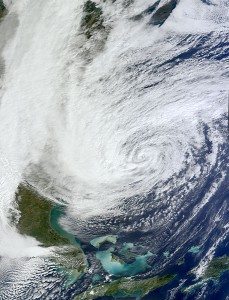Are we now experiencing the “new normal” climate? Let’s look at the recent evidence:
- A storm of historic proportions is moving up the east coast as a Nor’easter without precedent, since no such storm has ever had a hurricane from which it could draw energy, especially in late October
- Extreme heat has caused rail lines to buckle, major highways to bulge, and runways to melt.
- The past two years have been punctuated by what many have termed “weird weather”. Droughts and fires were followed by floods in Russia and Australia.
- Pakistan experienced unprecedented floods.
- Floods, flash floods, droughts, heat waves, fires, and freakishly large or early snowstorms have all ravaged parts of the United States one season after another.
- The severe drought and heat in Texas that produced dozens of consecutive days over 100 degrees in San Antonio in 2011 was, for example, followed by summer flooding to the same places in 2012.
- Drought conditions spread northward during the summer of 2012 so that hundreds of counties were declared disaster areas – declarations that reflected the potential of severe economic losses in agricultural productivity, infrastructure, and derivative economic activity.
- River levels in the Mississippi were so low in August of 2012 that river transport had to be curtailed to one light cargo ship or barge at a time. River traffic has been curtailed by low flow in the past, of course, but those episodes have recently been punctuated by some very severe flooding.
- Lightning has sparked wildfires in Colorado and other western states, and their devastating impact has been fuelled by dead trees that are the products of bark beetle infestation.
- Multiple episodes of heavy rainfall and other extreme weather events over short periods of time have dotted the United States and have produced multiple impacts, including flooding of critical infrastructure. Five inches of rain in an afternoon is now not at all extraordinary.
- Damages attributed to northeastern hurricanes like Irene and even routine Nor’easter’s have been amplified not only by drenching and stalled rainfall from those storms, but also by saturated land that had been weakened by earlier extreme and/or prolonged rainfall events.
Given all of these observations and others, it is reasonable to ask “Are we now experiencing the “New Normal”?
The subtext here is the unstated conclusion that the “Old Normal” that was defined by the last two or three decades of the 20th century and the first decade of the 21st century is indeed broken.
We have very high confidence that this is true, and it means that decisions taken at every level must henceforth recognise that the climate is dynamic and that the future will not look like the past.
It follows that the answer to the question about the “New Normal?” questions is “NO – because each year in this decade and the next and the one after that is and will be at most a snapshot of changing climate along a trajectory that will ultimately converge to a yet to be defined “new normal”.
The National Research Council (NRC) reports two important and informative findings to explain why.
First of all, the changes in the current climate that have been observed across the planet are the products of only about 50% of the warming to which we are already committed, thanks to our past emissions of heat-trapping gases. This means that the planet would warm another 2-4 degrees Fahrenheit through the middle of this century even if concentrations of heat-trapping gases were to achieve their maximum tomorrow. This is not likely, since sustaining a specific concentration starting tomorrow would require an 80% reduction in emissions overnight.
Moreover, the NRC reported that the long-term equilibrium climate will be determined by maximum atmospheric concentrations of these heat-trapping gases. It follows that we will continue to commit ourselves to more and more warming and more and more climate change and increasingly intense and frequent extreme weather events until atmospheric concentrations have in fact been stabilised.
To summarise, what we have been experiencing recently is only the harbinger of a future that will be punctuated by more severe weather extremes and increasing damage – all driven as the future unfolds by past and future emissions of heat-trapping gases.
We are NOT seeing the “new normal”!
Gary W Yohe is Huffington Foundation Professor of Economics and Environmental Studies at Wesleyan University
This article was originally published on The Conversation – theconversation.edu.au. Reproduced with permission.










